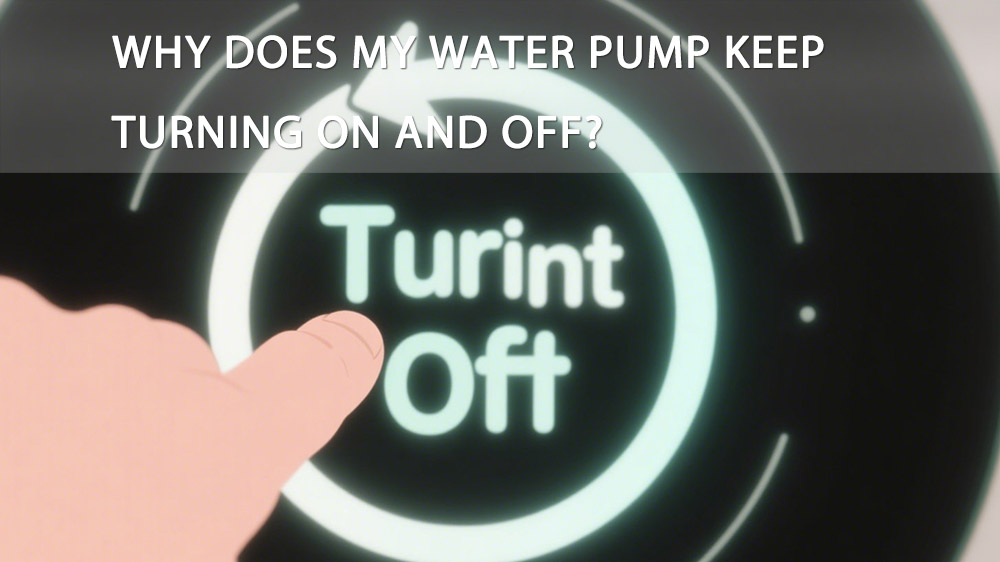+86 13816508465
Apr. 23, 2025

Water pumps are essential for countless applications, from residential water supply to industrial systems. However, a common frustration many users face is a pump that cycles on and off repeatedly—a problem known as short cycling.This issue not only disrupts water flow but also strains the pump, increases energy consumption, and shortens the equipment's lifespan.
In this guide, we'll explore why submersible pumps, centrifugal pumps, circulation pumps, and well pumps might short-cycle, how to diagnose the root cause, steps to resolve it, and best practices to prevent recurrence. Let's dive in.
1. Submersible Pumps: Diagnosing and Fixing Short Cycling
Common Causes:
- Low Water Level: If the water level in the well or tank drops below the pump's intake, it may suck in air, triggering rapid cycling.
- Faulty Pressure Switch: A malfunctioning switch fails to maintain consistent pressure, causing the pump to restart frequently.
- Leaky Pipes or Check Valve: A damaged check valve allows water to flow back into the source, reducing system pressure.
- Oversized Pump: A pump too powerful for the system’s demand can empty the pressure tank too quickly.
Troubleshooting Steps:
1. Check the water level in the well or tank. If low, wait for it to refill or lower the pump.
2. Inspect the pressure switch for debris or corrosion. Test its calibration (standard cut-in pressure is 30–40 psi; cut-out is 50–60 psi).
3. Examine the check valve for leaks. Replace it if it doesn't close fully.
4. Verify the pressure tank's air charge. If the bladder is ruptured, the tank won't hold pressure, forcing the pump to cycle.
Solutions:
- Install a low-water cutoff sensor to protect the pump.
- Replace a faulty pressure switch or check valve.
- Downsize the pump if it's overpowered for your needs.
Prevention Tips:
- Regularly monitor water levels and well performance.
- Schedule annual maintenance for pressure switches and valves.
- Size pumps appropriately during installation.
2. Centrifugal Pumps: Addressing Rapid Cycling
Common Causes:
- Cavitation: Air bubbles are forming in the pump due to low suction pressure damage impellers and destabilizing flow.
- Clogged Intake or Strainer: Restricted water flow causes pressure drops.
- Worn Impeller or Seal: Reduced efficiency leads to inconsistent pressure.
- Incorrect Pressure Tank Settings: A misadjusted tank amplifies pressure swings.
Troubleshooting Steps:
1. Inspect the intake line and strainer for blockages.
2. Listen for cavitation noises (a sound like gravel in the pump).
3. Check the impeller for wear or damage.
4. Test the pressure tank's pre-charge (should be 2 psi below the cut-in pressure).
Solutions:
- Clean or replace clogged filters and strainers.
- Repair or replace damaged impellers and seals.
- Adjust the pressure tank settings or install a larger tank to buffer demand.
Prevention Tips:
- Use a suction gauge to monitor inlet pressure and avoid cavitation.
- Install a variable frequency drive (VFD) to match pump speed to demand.
- Replace worn components during routine maintenance.
3. Circulation Pumps: Solving Frequent Cycling in Closed Systems
Common Causes:
- Air Trapped in the System: Air pockets disrupt flow and pressure stability.
- Dirty Filters or Heat Exchangers: Reduced flow forces the pump to work harder.
- Faulty Thermostat or Control Board: Erratic signals cause unnecessary starts/stops.
- Undersized Piping: Narrow pipes create excessive resistance.
Troubleshooting Steps:
1. Bleed air from the system using vents or valves.
2. Clean or replace filters and inspect the heat exchanger for scaling.
3. Test the thermostat and control board for proper operation.
4. Verify pipe sizing matches the pump's flow rate requirements.
Solutions:
- Install automatic air vents to purge trapped air.
- Flush the system to remove debris and mineral buildup.
- Upgrade piping or install a bypass line to reduce resistance.
Prevention Tips:
- Use corrosion inhibitors in hydronic systems.
- Conduct seasonal flushing of heating/cooling loops.
- Ensure controls are calibrated to avoid overreacting to minor temperature changes.
4. Well Pumps: Tackling Short Cycling in Water Wells
Common Causes:
- Well Recovery Issues: Slow-refilling wells can't keep up with pump demand.
- Fractured Drop Pipe: Cracks allow water to leak back into the well.
- Faulty Pressure Tank: A waterlogged tank provides no buffer for pressure changes.
- Sediment Buildup: Sand or grit clogs the pump intake or pressure switch.
Troubleshooting Steps:
1. Measure the well's recovery rate. If it is too slow, reduce water usage or deepen the well.
2. Inspect the drop pipe for leaks or cracks.
3. Test the pressure tank by tapping it: A hollow sound means it's functional; a thud indicates waterlogging.
4. Clean the pump intake and pressure switch of sediment.
Solutions:
- Install a cycle stop valve to extend run times.
- Replace a waterlogged pressure tank.
- Use a sand separator if sediment is a recurring issue.
Prevention Tips:
- Schedule annual well inspections and pump tests.
- Install a low-pressure cutoff switch to protect against dry running.
- Opt for a constant pressure system to minimize cycling.
General Prevention Strategies for All Pump Types
1. Regular Maintenance: Clean filters, inspect seals, and test pressure switches quarterly.
2. Proper Sizing: Work with a professional to match pump capacity to system requirements.
3. Pressure Tank Care: Monitor air charge levels and replace tanks every 5–10 years.
4. Leak Detection: Fix dripping faucets or pipe leaks promptly to avoid pressure drops.
Conclusion
Short cycling is often a symptom of an underlying issue—not the problem itself. By methodically checking components like pressure switches, tanks, valves, and intake systems, you can identify and resolve the root cause. Proactive maintenance and smart system design will ensure your pump operates smoothly for years to come.
If DIY troubleshooting fails, consult a licensed technician to avoid costly damage. Remember: A well-maintained pump is a reliable pump!
Address
No.17 XeDa Jimei Ind. Park, Xiqing Economic Development Area, Tianjin, China
Telephone
+86 13816508465
QUICK LINKS